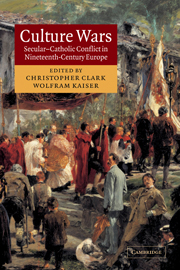Book contents
- Frontmatter
- Contents
- List of illustrations
- List of contributors
- Introduction: The European culture wars
- 1 The New Catholicism and the European culture wars
- 2 ‘Clericalism – that is our enemy!’: European anticlericalism and the culture wars
- 3 ‘Priest hits girl’: on the front line in the ‘war of the two Frances’
- 4 The battle for monasteries, cemeteries and schools: Belgium
- 5 Contested rituals and the battle for public space: the Netherlands
- 6 Nonconformity, clericalism and ‘Englishness’: the United Kingdom
- 7 The assault on the city of the Levites: Spain
- 8 Roma o morte: culture wars in Italy
- 9 Enemies at the gate: the Moabit Klostersturm and the Kulturkampf: Germany
- 10 Village quarrels and national controversies: Switzerland
- 11 The Counter-Reformation's last stand: Austria
- 12 The uncivil origins of civil marriage: Hungary
- Annotated bibliography
- Index
Introduction: The European culture wars
Published online by Cambridge University Press: 23 July 2009
- Frontmatter
- Contents
- List of illustrations
- List of contributors
- Introduction: The European culture wars
- 1 The New Catholicism and the European culture wars
- 2 ‘Clericalism – that is our enemy!’: European anticlericalism and the culture wars
- 3 ‘Priest hits girl’: on the front line in the ‘war of the two Frances’
- 4 The battle for monasteries, cemeteries and schools: Belgium
- 5 Contested rituals and the battle for public space: the Netherlands
- 6 Nonconformity, clericalism and ‘Englishness’: the United Kingdom
- 7 The assault on the city of the Levites: Spain
- 8 Roma o morte: culture wars in Italy
- 9 Enemies at the gate: the Moabit Klostersturm and the Kulturkampf: Germany
- 10 Village quarrels and national controversies: Switzerland
- 11 The Counter-Reformation's last stand: Austria
- 12 The uncivil origins of civil marriage: Hungary
- Annotated bibliography
- Index
Summary
Across Europe, the emergence of constitutional and democratic nation-states was accompanied by intense conflict between Catholics and anticlerical forces over the place of religion in a modern polity. There had always been intermittent institutional friction between church and state in central and western Europe, but the conflicts that came to a head in the second half of the nineteenth century were of a different kind. They involved processes of mass mobilisation and societal polarisation. They embraced virtually every sphere of social life: schools, universities, the press, marriage and gender relations, burial rites, associational culture, the control of public space, folk memory and the symbols of nationhood. In short, these conflicts were ‘culture wars’, in which the values and collective practices of modern life were at stake.
In Prussia, the largest member state of the German Empire, Otto von Bismarck's government launched a salvo of laws intended to neutralise Catholicism as a political force, triggering a ‘struggle of cultures’ (Kulturkampf) that shaped the contours of German politics and public life for more than a generation. In Italy, the annexation of the Papal States and the city of Rome, and the ‘imprisonment’ of the pope within the walls of the Vatican produced a stand-off between the church and the secular Kingdom of Italy, with far-reaching consequences for Italian political culture. In France, the elite of the Third Republic and the forces of clericalism waged bitter rhetorical battles, to the point where it seemed that secular and Catholic France had become two separate realities.
- Type
- Chapter
- Information
- Culture WarsSecular-Catholic Conflict in Nineteenth-Century Europe, pp. 1 - 10Publisher: Cambridge University PressPrint publication year: 2003
- 14
- Cited by

